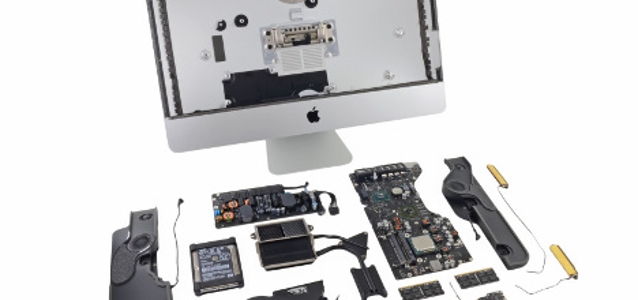
© iFixit
Electronics Production |
iFixit: iMac 21.5" Late 2012 Teardown
The late 2012 iMac 21.5" - code-named EMC 2544 - is an exercise in disappointment for us. We were quite worried when we saw that super-thin bezel during Apple's keynote, and unfortunately we were correct: the glass and LCD are now glued to the iMac's frame with incredibly strong adhesive. Gone are the lovely magnets that held the glass in place in iMacs of yesteryear.
We don't want to be sad Eeyores through this entire press release, but unfortunately the bad news doesn't stop there. Once inside, folks can still replace the RAM, hard drive, and CPU, but they'll have to remove the entire logic board before doing so -- everything is located on the back of the board, nooked right into the iMac's slim frame. Consequently, this year's unit received a super-sad 3 out of 10 repairability score, down from a healthy 7 on last year's unit.
Hackers, tinkerers, and repairers be forewarned: get last year's model if you'd like to alter your machine in any way. Highlights (if you can call them that): To our dismay, we must break out our trusty heat gun and guitar picks to get past the adhesive holding down the glass and LCD. We were fairly surprised to see that the new iMac's LCD sports the same model number as last year -- LM215WF3 from LG -- even though the LCD is 5 mm thinner. By switching from a traditional 3.5" desktop hard drive to a 2.5" laptop drive, Apple designers were able to free up lot of real estate inside the iMac. Apple turned to HGST -- formerly Hitachi, now a Western Digital company -- to manage the iMac's spinning storage. A rubbery housing is lightly adhered to the edges of the hard drive beneath the upper and lower hard plastic bezels. This design is far different from what we've seen before. Since the internal components are more tightly packed than before, small vibrations may carry through more components. The rubber housing dampens the vibrations from the spinning hard drive so they are not perpetuated throughout the device. A new fan layout! Apple is changing things up quite a bit and has moved from multiple small fans to a single centralized fan. "1" may be the loneliest number, but removing 2/3 of the fans goes a long way towards saving space. Judging by the orientation of the fan, we gather that it draws cool air from the bottom vents, then blows hot air out of the grating in the back of the iMac. The webcams in iMacs of yesteryear have always been connected to the logic board with long snaking cables that were relatively fragile; that is no longer the case. A ribbon cable we can only describe as "beefy" keeps the FaceTime HD camera in touch with the logic board. The newest iMac features not one, but two microphones. Dual microphone technology has been utilized in mobile devices for years to cut out background noise during phone calls. Now, the same idea is being applied here to improve sound quality during intimate FaceTime chats with your mother. The speakers may look simple, but removing them is nerve-wracking. For seemingly no reason other than to push our buttons, Apple has added a notch to the bottom of the speaker assemblies that makes them harder-than-necessary to remove. Good news: You can upgrade the iMac's RAM. Bad news: You have to unglue your screen and remove the logic board in order to do so. This is just barely less-terrible than having soldered RAM that's completely non-removable. After a short hiatus, Broadcom is back to bring WLAN capabilities to the iMac. A Broadcom BCM4331 single-chip WLAN solution dominates the tiny AirPort card.© iFixit
Off comes the honkin' heat sink! And along with it - the CPU??? The new iMac uses a spring-loaded, FCLGA1155 socket to make all those little electrical signals go into, and out of, the CPU Chips on the logic board include:© iFixit
- Intel Core i5-3330S, clocked at 2.7 GHz
- Nvidia GeForce GT 640M GPU
- Intel E213B384 platform controller hub
- Texas Instruments Stellaris LM4FS1AH5bb microcontroller
- 2x Hynix H5GQ2H24AFR GDDR5 SGRAM
- Broadcom BCM57765A1KMLG
- Intel DSL3510L Thunderbolt controller
- Analog Devices SSM3302 audio amplifier
- Vimicro VC0359 webcam processor
- Intersil ISL6364 multi-phase pulse width modulation (PWM) controller
- Cirrus Logic 4206BCNZ audio controller
- National Semiconductor VM22AC


